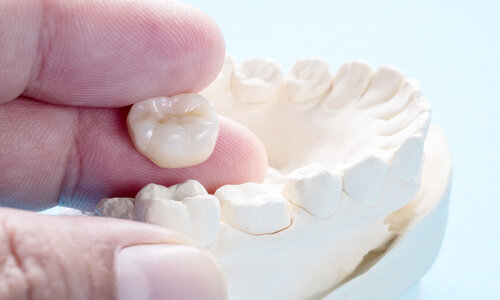Porcelain Dental Crowns: Advantages and Disadvantages
 By
By
The modern procedure of dental prosthetics, as a rule, is
accompanied by the installation of crowns. Various materials are used for the
manufacture of these elements. One of the most popular options is porcelain dental
crowns. Let's take a closer look at these designs, which are
regularly used in dental practice.
What are porcelain crowns?
Porcelain crowns are products that are distinguished by
maximum attractiveness and naturalness. For their manufacture, pressed ceramics
are used without the addition of metal impurities. Although porcelain crowns
are inferior to metal-ceramic and metal crowns in terms of strength, they are
often used in aesthetic dentistry.
What is the main difference between porcelain structures?
Such material is capable of transmitting light rays, due to which prostheses
are almost impossible to distinguish externally from natural teeth.
Porcelain crowns are mainly installed on the front teeth.
But, as you can find out here,
designs can also be used for lateral dentition. In this case, additional
reinforcement with zirconium frameworks is required.
How porcelain crowns are made
Creating dental crowns from porcelain is a painstaking
process that requires the use of expensive equipment. Only a qualified dental
technician can cope with the task properly.
There are two techniques for making porcelain crowns —
layering and injection molding, which allows you to get a more durable product.
This procedure consists of the following steps:
- Tooth
preparation, choice of crown color;
- Taking
impressions for making a model of the jaw;
- Creating
a mold from platinum foil into which porcelain will then be poured;
- Heat
treatment of the crown to increase strength;
- Final
color and shape correction;
- Staining
and glazing.
When to install porcelain crowns
Porcelain crowns have clear indications for installation.
They can be used in these situations:
- Aesthetic
restoration of the front teeth (the presence of defects — cracks, chips,
discoloration, etc.);
- Correction
of a slight curvature of the dentition;
- Prosthetics
of teeth after injuries and other damages.
Please note: the installation of porcelain crowns is not
recommended in the presence of inflammatory processes in the oral cavity (acute
or chronic periodontitis), bruxism, and diagnosed malocclusion.
Advantages and disadvantages
Porcelain crowns have many advantages that make them very
popular among patients. These include:
- Absolute
biological inertness of the material. Such crowns do not cause allergic
reactions and can be safely installed in case of allergy to metals. In
addition, they do not stain the gums with constant contact.
- Porcelain
retains its original color throughout the entire period of operation and
does not change under the influence of food dyes.
- The
possibility of using for the manufacture of bridges in the presence of a
framework of zirconium.
- Maximum
resemblance to natural teeth.
Porcelain crowns also have disadvantages. They are more
fragile structures than metal and metal-ceramic prostheses. Dentists also note
their high abrasiveness, which negatively affects adjacent teeth, insufficient
fit to the gums, and high cost.
Which dental crown is right for you? Only an experienced
dentist can answer this question after a thorough examination. Take care of
your smile and do not put off a visit to a specialist!






